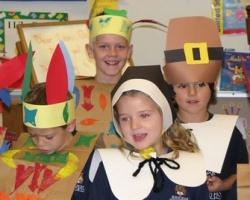For decades, Claremont kindergartners have celebrated Thanksgiving by dressing up as pilgrims and Native Americans and sharing a feast. But on Tuesday, when the youngsters meet for their turkey and songs, they won’t be wearing their hand-made bonnets, headdresses and fringed vests.
Parents in this quiet university town are sharply divided over what these construction-paper symbols represent: A simple child’s depiction of the traditional (if not wholly accurate) tale of two factions setting aside their differences to give thanks over a shared meal? Or a cartoonish stereotype that would never be allowed of other racial, ethnic or religious groups?




